The Making of COCOON's Minimalistic, Synth-Filled Universe
An in-depth conversation with Erwin Kho and Jakob Schmid about making their award-winning game
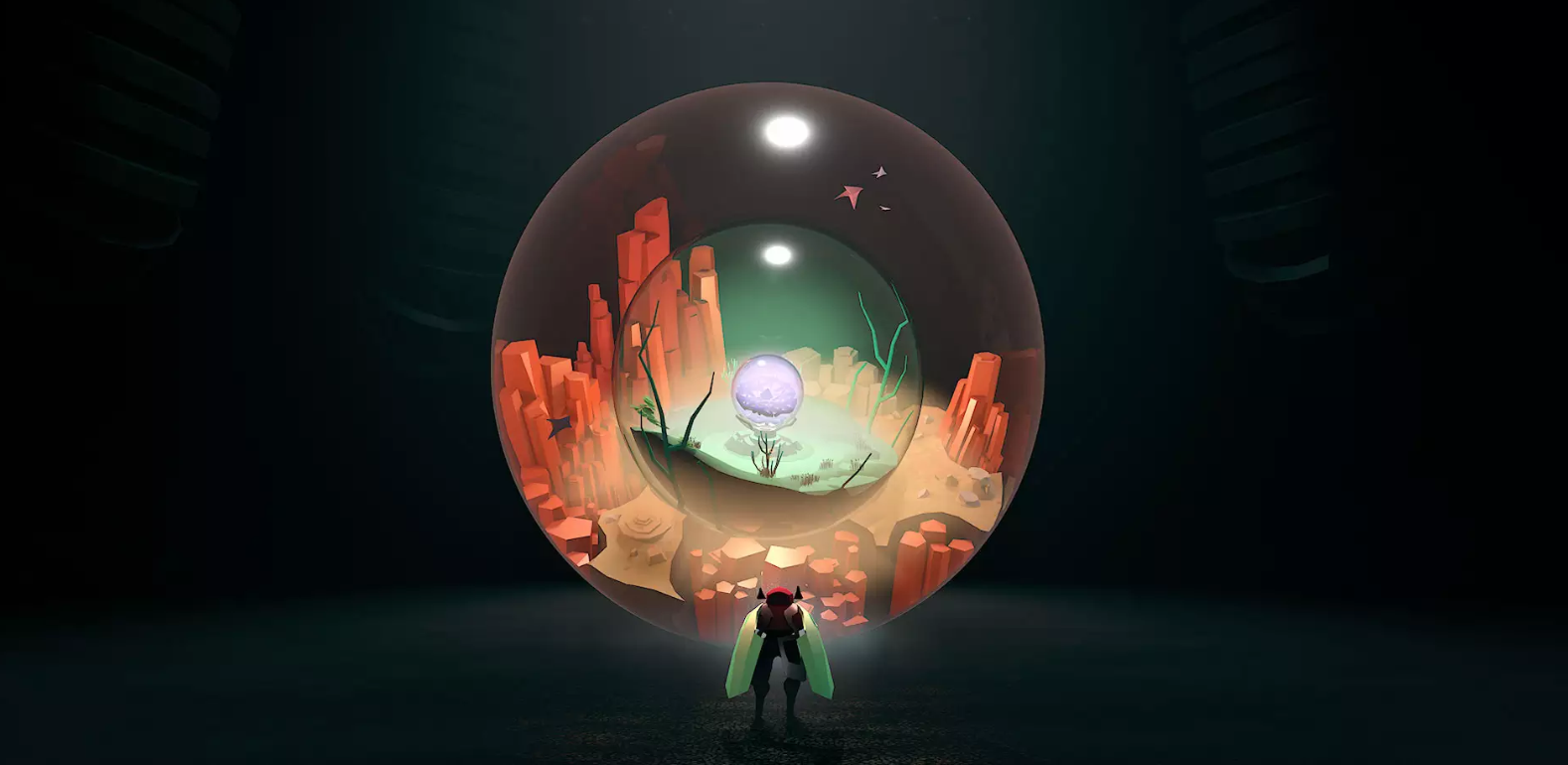
It has been a couple of months since COCOON, Geometric Interactive's debut game (of the year, as certified by Geoff Keighley and company during the recent Game Awards), blessed us with its low-poly, mind-bending presence. Despite a year jam-packed with some of the most original and creative titles indie-heads like myself could've only dreamed of – DREDGE, Planet of Lana and Chants of Sennaar to name a few – it is Jeppe Carlsen's and Jakob Schmid's environmental puzzle game that I can't get out of my head, like a worm that wiggled into my mind and decided to live there rent-free.
Speaking of bugs: in COCOON, you control a winged insect-like creature whose role in this alien, H.R. Giger-inspired world – similarly to previous titles, LIMBO and INSIDE (which Carlsen is also responsible for) – is left for players to figure out, ambiguous as it is. The only thing we know, however, is that it's capable of carrying orb-like marbles. Press a button (there's only one action button in the game), and the insectoid carries it on its back. Find a puddle, press the button to put it down, then the same button once again (a bit longer, this time), and, oh, you're inside of it.
Once the player figures out there's more than one globe and every one of them can be carried/stacked inside one another, like an adaptive matryoshka doll of sorts, you're simply overwhelmed with all the possibilities this simple yet novel mechanic opens up.

Still, no matter how clever a game is or how smoothly it plays, much of the experience is related to audio design. This is particularly important in games like COCOON where most of the time players will be running around in and out of the world(s). If you've seen Christopher Nolan's Inception, you probably know how easy it is to lose track of things with all the world-within-a-world-within-a-world excitement. Not that there's anything to worry about: Schmid gently, almost as if with an invisible hand, nudges players in the right direction with well-timed audio cues.
Unsure if you have carried the orb inside another one in the right order? Not a problem: COCOON's seamless audio design will let you know. It will make you listen. As a Scooby snack for doing that, for completing each puzzle that will leave you smiling or simply in awe, you also get rewarded with delightful bits of music reminiscent of reaching the test chamber's exit in Valve's Portal.
It's only after the player starts juggling different orbs on their back, hopping in and out, in and out from each one, that they start to grasp what an interesting, tightly-knit cosmos they've been plopped into. "Alive and synthetically created at the same time," as Schmid neatly sums it.
Despite being completely desolate – save for insects scurrying on some faraway rocks and an occasional, cutesy alien creature that has no choice but to help you out – each world is built with purpose and has its own distinct feel. Sure, there will be instances where you might feel lost and confused, tempted to consult with a walkthrough guide – something even the masterclass puzzle games, like The Witness or Outer Wilds, are faulty of. But with Schmid's audio cues working in tandem with COCOON's level design, players don't get to wander for too long. Nor get bored of it. This is a tremendous achievement for Erwin Kho, who, as we learn, hasn't done level design/world-building of this scale ever before.
Having said that, we are hardly surprised that COCOON nabbed that debut indie Game of The Year award. If there's a better incentive to give it a try, we aren't aware of it (okay, it's also on Game Pass – that counts). So, to celebrate this special occasion, SUPERJUMP sat down with Jakob Schmid and Erwin Kho, audio director and art director of COCOON, to learn what went into making of this minimalist, instant classic. Hopefully, it won't be another 5-6 years before we get to witness what Geometric Interactive is up to next.
SUPERJUMP: What were your main inspirations for COCOON?
Erwin Kho (art director): The architecture was inspired by insect colony nests, like those of ants and wasps. They make their nests out of local materials, and I felt that there’s something very majestic about the idea of an alien culture that has buildings that seem grown out of their surroundings. This is a culture at the height of its power – they can warp entire planets into tiny marbles, so I wanted the architecture and technology to reflect this level of intelligence and control over the environment.
It also had to look purposeful and beautiful. For this, I was very inspired by a mix of brutalist and art-deco architectural styles, sea creatures like sea urchins and starfish, and insect body parts (like, for example, cicada wings).
Jakob Schmid (audio director/composer): The inspiration for the music aesthetics was primarily New Age music from the 1970s and early 1980s. In particular, the mysterious synthetic soundscapes of Tangerine Dream and the enormous sound of Vangelis' classic Blade Runner soundtrack, as well as his amazing 'Spiral' album. I'm also drawn to music with a lot of harmonic tension, and for this, I was always inspired by Chick Corea, especially his Elektric Band albums.
My original inspiration for the ambient background music was the Amiga game Dune II, the real-time strategy game that games like Command & Conquer and Warcraft were based on, as well as the original Demon's Souls. These games inspired me to make a non-intrusive ambient soundtrack that isn't afraid to have long pauses.
Finally, the 4K demo 'CDAK' from 2010 with generative music by Lassi Nikko (also known as Brothomstates), has been a major inspiration for me for the last 10 years. It is a powerful 4-minute demonstration of just how far computer music can be taken, and I will keep trying to make something as impressive.
Source: YouTube.
"My original inspiration for the ambient background music was the Amiga game Dune II, the real-time strategy game that games like Command & Conquer and Warcraft were based on, as well as the original Demon's Souls."
Jakob Schmid
Audio Director/Composer
SUPERJUMP: I read that all sounds in the game are synthesized. How did you come up with this approach, and was it difficult to pull off?
Jakob Schmid: From the beginning, I wanted to make a generative soundtrack for the game based on software synthesizers. I liked the idea of music with no loops for a puzzle game with potentially long "thinking breaks", and how every play session could have a somewhat unique soundtrack.
With that idea in mind, I thought about what sound design aesthetic could fit the very synthetic sound of generative music. I was watching the original Dragon Ball series from the 1980s, and I noticed that a lot of the sound effects were clearly made with synthesizers. It worked well, even though it sounded artificial.
I also had quite a lot of experience using synthetic sound design for Jeppe's and my previous game 140. And finally, I thought synthetic sound effects could fit Erwin's worlds that to me felt both alive and synthetically created at the same time.
When we hired our amazing sound designers, Julian Lentz and Mikkel Anttila, they took this concept and ran with it in a way I couldn't have predicted. They synthesized footsteps, rain, thunder, alien creatures, and mechanical devices with a degree of realism and detail I couldn't have dreamt of.
SUPERJUMP: You used musical cues to guide players in the right direction – music as a game mechanic. Can you explain your approach to this?
Jakob Schmid: This was originally Jeppe's idea. He wanted to guide the players in certain key puzzles that involved multiple worlds. It was tricky to do visually, as some of the elements of these puzzles were located in other worlds, not visible to the player. Jeppe came up with the idea of musical puzzle feedback that would be triggered when certain requirements were met, to affirm the player that they were on the right track.
I had some music lying around that was based on experiments with analyzing song vocals and turning them into musical notes, and decided to chop the results up and use them for this musical feedback.
SUPERJUMP: Perhaps there was something important you learned while working alongside Martin Stig Andersen on INSIDE that changed your approach to audio design/composing – something that really helped while making COCOON?
Jakob Schmid: Working with Martin was incredibly inspiring, and one of the main ideas that inspired me from work on INSIDE was the blurring of the line between sounds that are in the game world and music that is external to the game world; how one can transition into the other. Early on in the development of COCOON, this idea was a big inspiration to me.
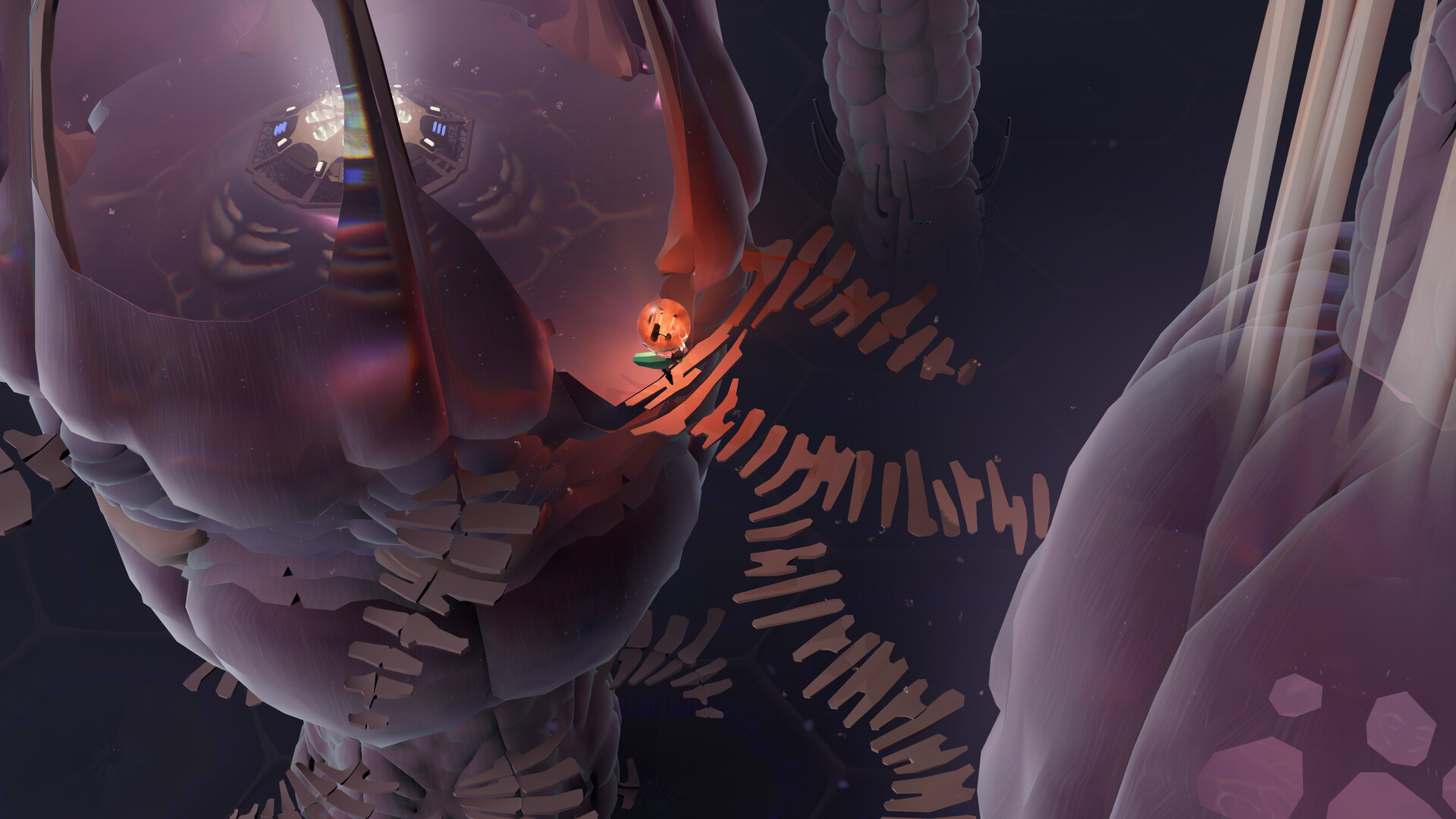
"I liked the idea of music with no loops for a puzzle game with potentially long "thinking breaks", and how every play session could have a somewhat unique soundtrack."
Jakob Schmid
Audio Director/Composer
SUPERJUMP: Was there any particular track you had a rather difficult time perfecting?
Jakob Schmid: The generative music for the boss in the green world was tricky to make. It needed to both be responsive to the action and still sound good. We had a technical issue with a delay effect having incorrect timing on certain platforms. I was making modifications and improvements to the music up until the very last minute. However, I'm very happy with where it landed.
SUPERJUMP: If I’m not mistaken, besides "Islands", your three-part low-poly scene collection, COCOON is the biggest world you’ve fleshed out. Was it challenging to develop the general aesthetic of COCOON?
Erwin Kho: COCOON is by far the biggest project I’ve ever worked on, and there were plenty of challenges for me. It seems so obvious now, but there’s a huge difference between making floating little islands versus creating screen-encompassing environments.
I treated Islands as still lives. They’re very isolated from any context by being placed against a neutral background that kind of works as wallpaper. Everything that happens in those images is very much contained; it’s like having a slice of a landscape and treating that as a sculpture.
COCOON, on the other hand, is the complete opposite: the game needed fully-fledged environments, complete worlds that you feel immersed in so that it truly feels like travelling between biomes and worlds. It took a while to get used to the environments going beyond just one screen and different biomes flowing into each other. I had to think bigger.
Also, just filling the screen with polygons didn't quite work enough. There was a measure of refinement missing, so I ended up using vertex-painted textures on the models to give them some different splashes of colour here and there.
SUPERJUMP: Did Carlsen and Schmid have a specific tone/feel/atmosphere they had in mind before bringing you on board? Perhaps there’s a version of COCOON that looks nothing like the final game?
Erwin Kho: Jeppe and Jakob were not set in stone about a specific art style and were completely open, but they did lean towards an art style that was not too abstract. They felt that the idea of worlds within worlds felt much more fascinating if the worlds themselves felt like real places with their own biomes, animals, etc. So when they approached me, it was because of my Islands series; it was only natural that I expanded on that.
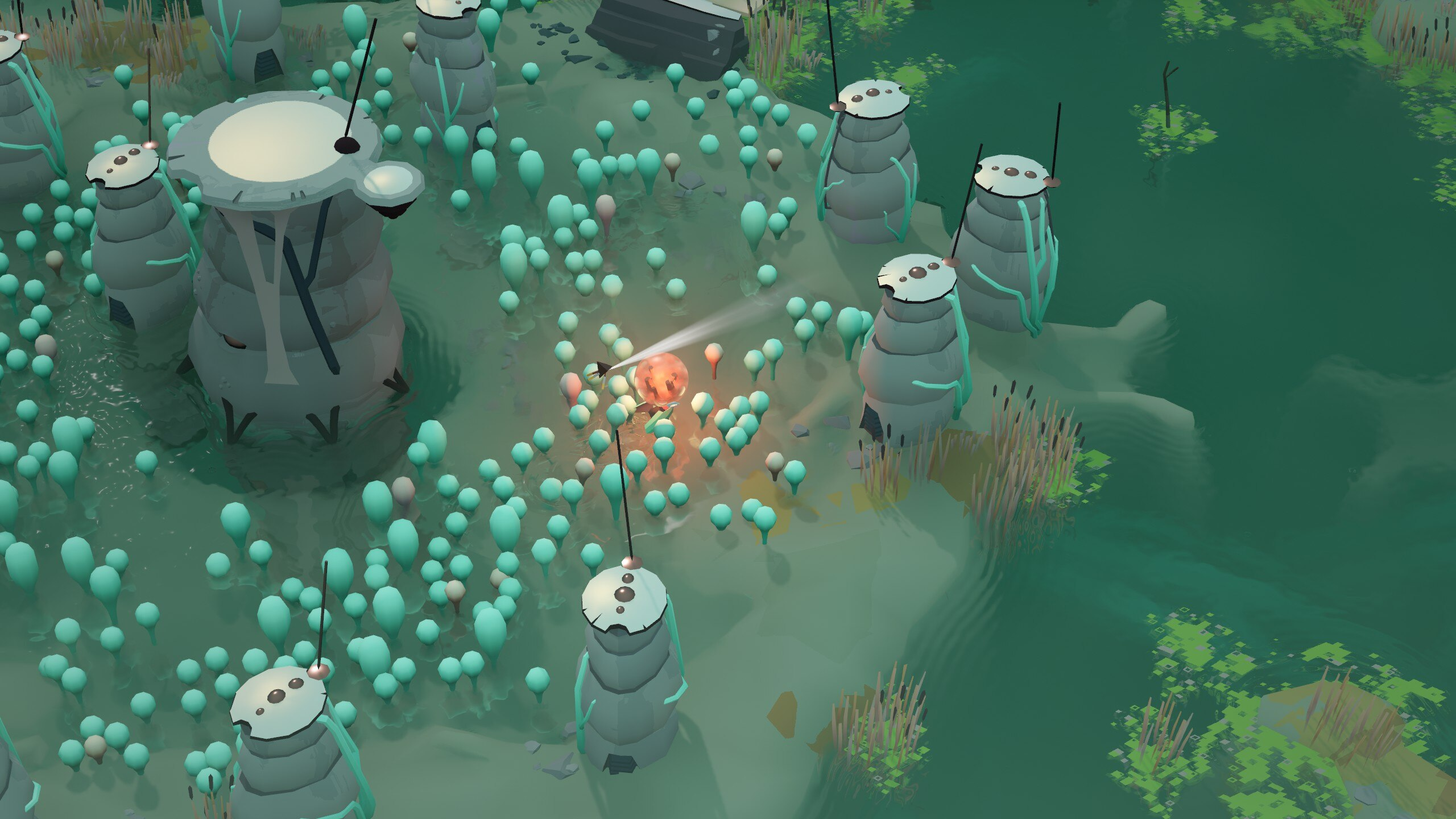
"It took a while to get used to the environments going beyond just one screen and different biomes flowing into each other. I had to think bigger."
Erwin Kho
Art Director
SUPERJUMP: Which part of your duties as the art director of COCOON was the most fun to fulfill?
Erwin Kho: The fun thing was that I got to design it all: landscapes, both natural and artificial, alien technology and architecture and traces of their civilization; gameplay elements and creatures and bosses… I think I would have been quite bored if I only got to design landscapes.
I had a great time designing the bosses, and in a way – they were perhaps much easier to design than the worlds. By the time I got to think about their designs, the world that they are the guardians of already existed, and the gameplay mockups of the boss fights would already be playable. So I knew what the parameters were going to be. This provided a very useful guideline that I could hook my ideas into.
For instance, the gameplay mockup of the 4th boss (the one where you dash around the arena) already had four legs that you’d have to smash into, and we knew that you’d have to smash the leg when it was encased in crystalized amber. For me, that quickly conjured up the association with honey bees’ legs that are loaded with yellow pollen.
And it had already been decided that you needed to free him from an amber cocoon to start the battle, as part of teaching that you can smash the amber. The image of a dead curled-up spider came to my mind for this, which happened to work perfectly together with it having these massive hairy legs.
I think the only non-gameplay-related design in this particular boss was its tall segmented body. I wanted a connection between this boss and the mining theme of this world. So it being fused with this massive drill, which had design elements you’d already have encountered beforehand, just made a lot of sense.
This tower design did keep the gameplay in mind, though: I wanted a huge body, but it shouldn’t obscure the player from the camera too much. So something tall and slender was the perfect solution.
SUPERJUMP: Each orb contains a different world that stands apart from the others. How long did it take you to set them apart thematically? Perhaps you have a favourite one?
Erwin Kho: Actually, I took a lot from the gameplay prototype that Jeppe and Jakob sent me before I started on the project. In that prototype, you were going through a grey-coloured hub world and you’d find a pink and green orb. I liked how a neutral colour scheme for the hub world really helped make the other colours pop. So it was more down to figuring out what kind of biomes would fit these colours.
I felt that, with the ability to manifest bridges, it’d make sense for the orange orb’s biome to be about height and cliffs. Why else would you need bridges if not to traverse ravines? That world quickly became inspired by places like the Grand Canyon.
With green being the complementary colour of orange, I quickly decided that it had to be very lush and full of life to contrast with the desert/canyon biome. Later I decided it not only had to contrast in terms of flora/fauna, but to add that extra contrast when compared to the orange world, the green biome had to be as flat as possible.
The purple orb’s biome being so organic made sense to me after travelling through all these ‘normal’ terrestrial biomes. At first, it was a bit tricky to tie it in with that orb’s ability (initially referred to as "Hologram" and then later as "Teleport"). I thought that if I wanted the biome to be so organic, maybe what this orb could do was quickly clone itself on all other pedestals. So the idea of cloning then led me to make all the shapes in the purple orb very repetitive and mirrored. Even the purple boss’ body is mirrored and then repeated into a conjoined triplet!
SUPERJUMP: What are the main influences behind your distinctive style? Perhaps you’re a fan of H.R. Giger?
Erwin Kho: It’s funny that people pick up on that. His work for ALIEN left such an impression on me and has been with me for most of my life – it’s often not even something I consciously think about anymore! There’s just something so fascinating about the organic complexity that I see in his work.
I think it’s similar to the medical books my dad had in his study. As a child, I was allowed to page through these beautiful (and expensive!) hand-drawn anatomy books filled with skeletons, muscles, and nervous systems. I think it really started my love for science and scientific visualization.
My 3D work, however, is very much inspired by early '90s 3D models. There’s a beautiful simplicity and honesty to them that I really appreciate. I never got into painting textures and then mapping them onto meshes – I always thought that was very tedious. Maybe because the result was not immediately visible to me, and also dependent on lighting setups, etc.
I also used clay a lot as a child, modelling all kinds of creatures and landscapes, so I feel my 3D process is very much an extension of that: it’s all about shapes and some colour.
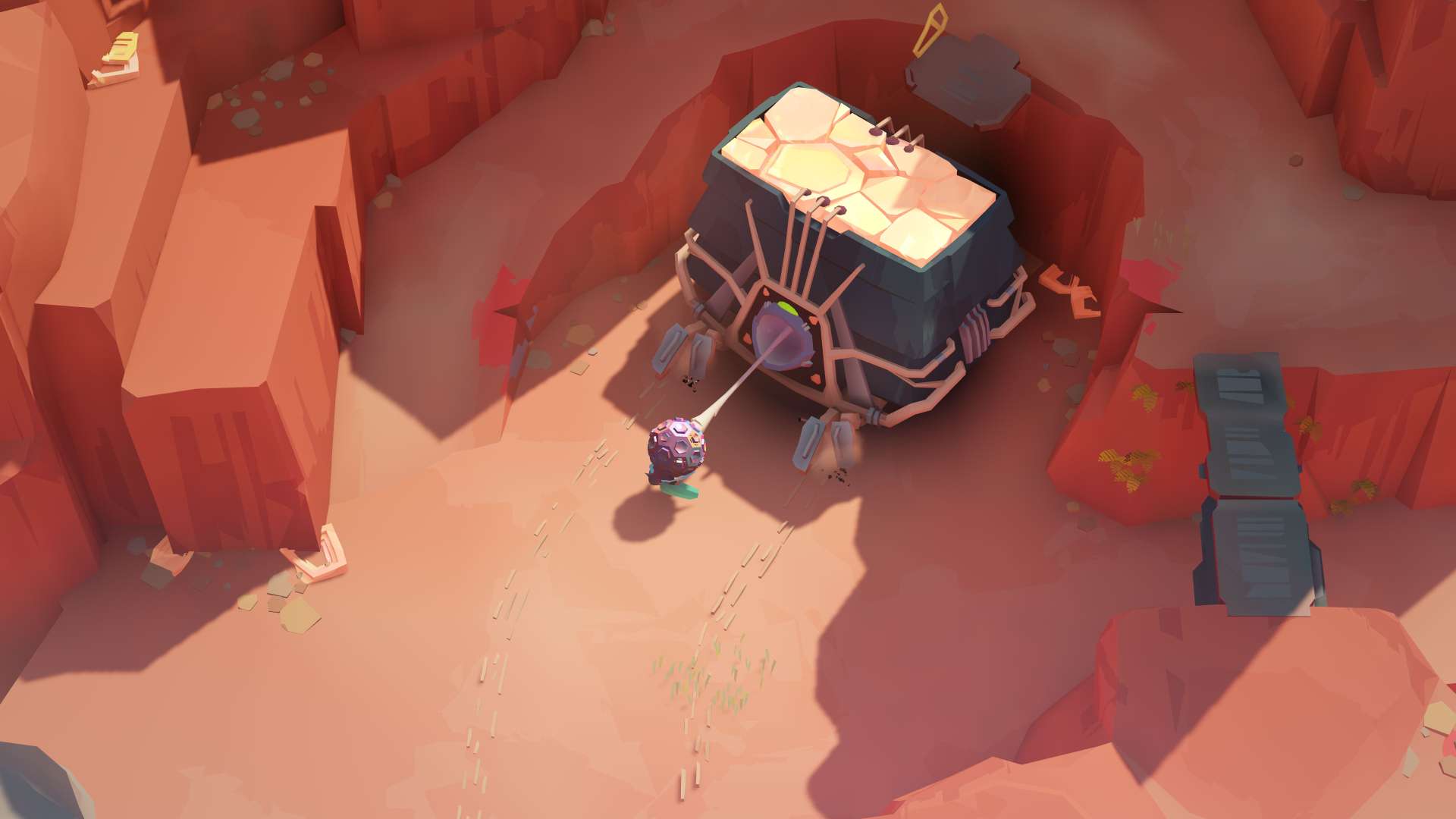
"I also used clay a lot as a child, modelling all kinds of creatures and landscapes, so I feel my 3D process is very much an extension of that: it’s all about shapes and some colour."
Erwin Kho
Art Director
SUPERJUMP: The game’s impressive quality lies in its immersive atmosphere, which is evident in how its sound design/music enhances world-building and vice versa. However, there's something of an age-old debate on style versus substance. What amount of style is substance when it comes to COCOON?
Jakob Schmid: Something we have discussed during development is that the world of COCOON has an alien quality to it, and objects in the world(s) are not immediately recognizable. The transition between worlds potentially adds to a feeling of being in an unreal place.
I think the high level of detail in the sound design creates a feeling of reality of the worlds – something that is required for the players to feel like they are in a real place.
Erwin Kho: I’d say most of it is substance, as COCOON is such a gameplay-focused game, the art really is in service of making sure the game feels great to play. I guess you could say we use style to make the environments look rewarding to play through.
The game’s visual atmosphere being so impressive is all thanks to our very talented colleague, Mikkel Svendsen, who was responsible for the rendering and lighting. His work really made the colours and shapes pop and it gave the worlds of COCOON a certain volume and tactility that simply elevated them from being mere stylized polygonal shapes.
The beautiful indirect lighting, the high dynamic range highlights, the way light and objects interact with the fog… that’s all his handiwork.
SUPERJUMP: What was the most challenging aspect of bringing COCOON to life?
Jakob Schmid: Creating synthesizers that could fill the role of soundtrack in the game without taking up too much CPU time. I worried a lot that the synths would be unstable or too taxing for the previous-gen consoles. It actually seems to work well, and that makes me very happy.
Erwin Kho: For me, it was to learn so much about level design and how to turn Jeppe’s level mock-ups into interesting environments that are also easy to parse and nice to play through. I had never done anything like this before, so it was a steep learning curve!
For example, my earliest landscapes had paths that were way too narrow, resulting in the player continuously bumping into colliders because of the restricted movement space. Or paths that were far too long, resulting in just walking too far.
It sounds so obvious now, but it was not something I ever consciously realized. I would say that having to learn all these gameplay-related aspects in the beginning also influenced the general process of developing the visual language of the game. It was hard to do both at the same time.
Over time, I got more used to what the requirements were for the game and this knowledge just became like second nature. That’s when the visual designs were often a bit easier to nail.
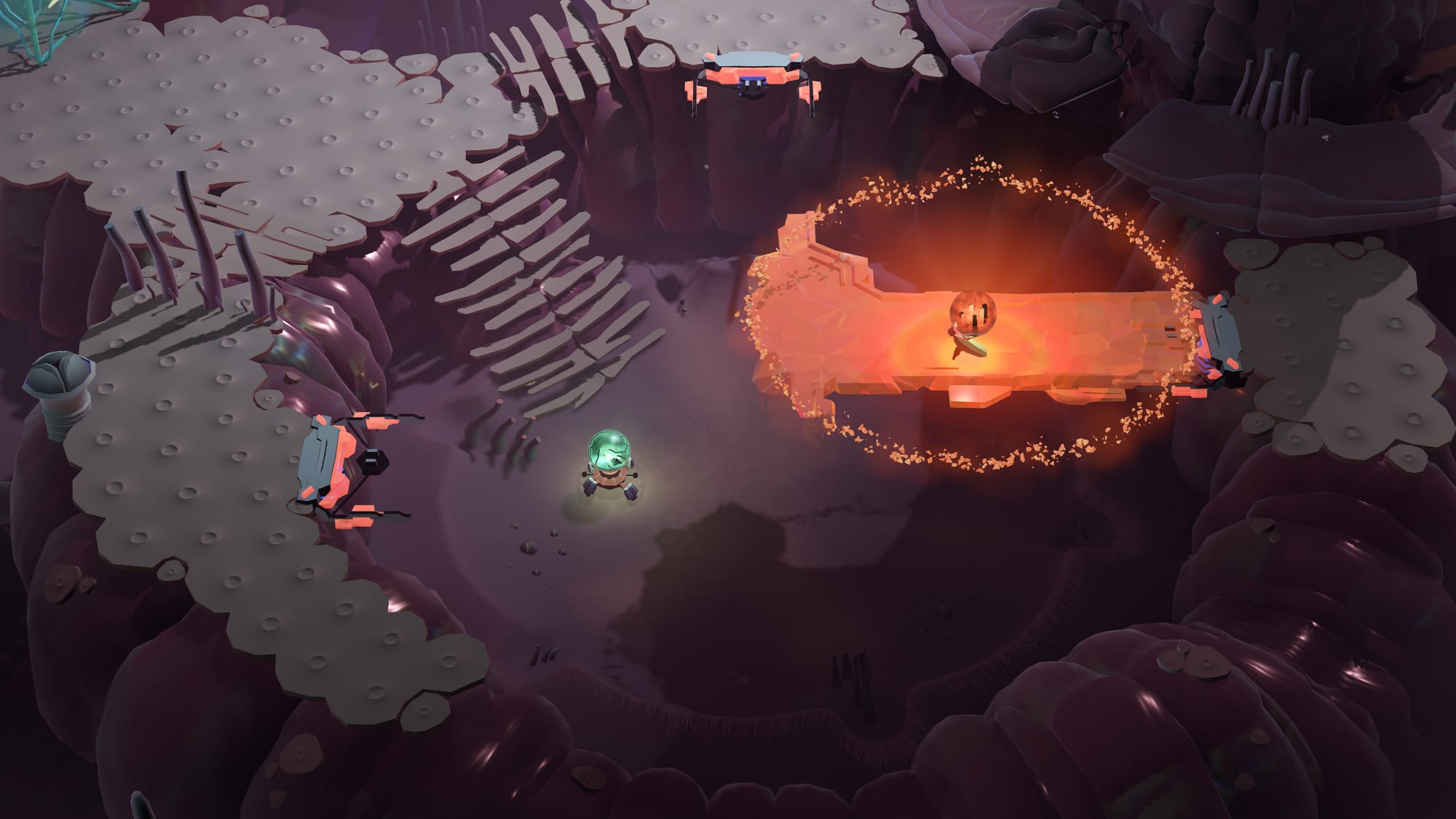
"I worried a lot that the synths would be unstable or too taxing for the previous-gen consoles. It actually seems to work well, and that makes me very happy."
Jakob Schmid
Audio Director/Composer
SUPERJUMP: Is there a feature/idea of yours you are proud of the most?
Jakob Schmid: I'm very proud that I managed to make generative music plugins that actually run on computers and consoles, generating different notes and timbres for every play session.
Erwin Kho: It’s difficult to pick a favourite one! There are quite a few that I’m very happy with, but to mention some:
The mechanism we refer to as the "Universe Bridge". It’s the tall pillar/door/window that you encounter three times towards the end of the game that allows you to enter a world without the use of a portal, leading to some very fun mind-breaking puzzles.
That one took such a long time for me to feel confident about. I worked on it off and on over a period of many months because I just couldn’t find the right inspiration for it. Because of the technical requirements, it was always imagined as a pillar/door of sorts.
In its earliest stages, it was like the monolith from 2001: A Space Odyssey. But I wanted something potentially more insect-inspired, yet still monolithic. We even had another Dutch designer, Joost Eggermont, do some concept research for us. The image boards he came up with were so cool and inspiring – they helped me a lot in steering the direction of the final design.
The idea behind the final model was that each shell (there are four that open up before manifesting a doorway into another world) is a representation of a level of reality. Opening up the mechanism actually breaches that level of reality, revealing the next underneath it, and so on, until you break through the deepest layer of reality, which then causes a bridge connection into another world.
SUPERJUMP: Working on the same game for half a decade is a pretty long time. Were there any recent games that did something interesting musically you’re excited to try out in your next project?
Jakob Schmid: Looking at the elaborate music systems of a game like Rytmos by Floppy Club. I felt that one of the next steps for my music systems is to build tools for fine-grained and direct control over melodic content and rhythmic synchronization of different instruments.
COCOON’s music systems are great for creating harmonic "clouds" of notes, but they are not suited for melodies; they don’t have much functionality for synchronization. This could be an interesting challenge for our next game.